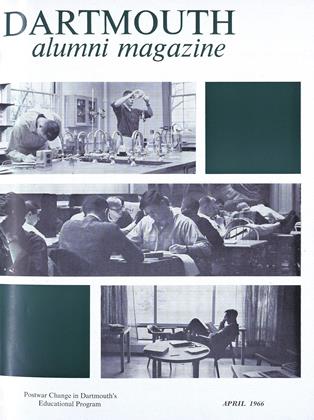By Alvin C. Gluek'45. Toronto, Canada: University of Toronto Press, 1965 . 311 pp. $7.50.
That other North Country, Minnesota, is celebrated and analyzed in this book which skillfully and painstakingly depicts the vigorous pioneer days of the upper Middle West. It binds the record of Minnesota's early history to the story of the slower development of Canada's Great Plains. And it reminds us that there were several periods when the tides of American destiny were thought to flow north rather than west.
Minnesota came to life at the beginning of the 1850's. When territorial status was granted in 1849 it counted less than 6000 inhabitants. In 1860 the figure had grown to more than 172,000. Thus in ten years the face of the northern prairies was drastically changed. To the north of the 49th parallel remained a thinly populated vastness governed by a paternalistic Hudson's Bay Company. South of the border farms, towns and cities proliferated. So did hopes and schemes designed to erase the international boundary and join an inexhaustible and almost limitless northern hinterland to the growing agricultural riculturaland commercial economy of Minnesota.
There were three events which acted as brakes on Minnesota's expansion in the first dozen years. The Panic of 1857 dried up the flow of credit, broke the land boom, and slowed the tide of settlers. The Civil War absorbed American energies in the East and South. And in 1862 the Sioux uprising drove back the northern frontier and dampened enthusiasm for the conquest of new land.
After 1865, however, the tide began to roll again. Ambitious Minnesotans had in the past often looked on the British Northwest Territories only as a partner in a commercial union. But in 1866, when Canadian- American reciprocity agreements came to an end, expansionist opinion came to view political annexation of "Central British America" as the only feasible solution. Senator Alexander Ramsey and James W. Taylor, publicist and short-term secret agent for the State Department, were Minnesota's most influential voices in Washington in pushing the annexationist designs. President Grant and Secretary of State Fish were favorable to the idea of extending the national boundaries to the north, but they were not prepared to consider armed force; and in the end only military means could have brought about annexation. For the fact was, despite the hopes and illusions of Minnesota's expansionists, the people of the British Northwest preferred confederation with Canada to incorporation in the United States.
The outcome of Louis Riel's rebellion in Manitoba put an end to American expansionist hopes. In 1869 Riel had led the French-Canadian and half-breed inhabitants of the Red River settlement in a rebellion which culminated in the declaration of an independent provisional government. Oscar Malmros, the American Consul in Winnipeg, worked assiduously to guide the rebels toward an allegiance to the United States. But Riel was clearly more interested in getting favorable terms for his people in negotiations to become part of Canadian confederation. In any case, Riel's rebellion collapsed in the summer of 1870 when a military expedition from Ottawa took over Winnipeg and the Red River settlement, and American hopes for northward expansion went glimmering.
One could wish that the author of this study had dealt with the drama of Canadian- Americanrelations in greater detail. Also, more and better maps would have helped the narrative. But, aside from these criticisms, we should be grateful to Professor Gluek for an interesting story well told.
Professor of Government
 View Full Issue
View Full Issue
More From This Issue
-
 Feature
FeatureTo Keep Pace with America
April 1966 -
 Feature
FeaturePostwar Change in Dartmouth's Educational Program
April 1966 By C.E.W. -
 Feature
FeatureDartmouth's "New" Curriculum
April 1966 By JOHN HURD '21, PROFESSOR OF ENGLISH EMERITUS -
 Article
ArticleThe Undergraduate Chair
April 1966 By LARRY GEIGER '66 -
 Class Notes
Class Notes1920
April 1966 By GEORGE H. MACOMBER, JOHN S. MAYER -
 Article
ArticleThe Faculty
April 1966 By GEORGE O'CONNELL
RICHARD W. STERLING
-
 Books
BooksTHE CASE FOR PEACE.
January 1956 By RICHARD W. STERLING -
 Books
BooksTHE UNITED STATES AND CANADA.
NOVEMBER 1964 By RICHARD W. STERLING -
 Books
BooksPROSPECTS FOR PEACEKEEPING.
MARCH 1968 By RICHARD W. STERLING -
 Books
BooksSOVIET-MIDDLE EAST RELATIONS (SOVIET-THIRD WORLD RELATIONS. Vol. I — A SURVEY IN THREE VOLUMES).
February 1974 By RICHARD W. STERLING -
 Cover Story
Cover StoryFragments of papyrus
DECEMBER • 1985 By RICHARD W. STERLING
Books
-
 Books
BooksTHE LETTERS OF EMILY DICKINSON.
OCTOBER 1958 -
 Books
BooksANTITRUST AND THE CHANGING CORPORATION.
April 1962 By GEORGE E. LENT -
 Books
BooksTURBULENT ERA. A DIPLOMATIC RECORD OF FORTY YEARS,
February 1953 By HAROLD R. BRUCF. -
 Books
BooksREBELS AND GENTLEMEN
December 1942 By Herbert Wells Hill -
 Books
BooksIntroduction to the Study of Public Administration
DECEMBER 1927 By JAMES P. RICHARDSON. -
 Books
BooksBack To The Land
JUNE 1983 By Jonathan Brownell


